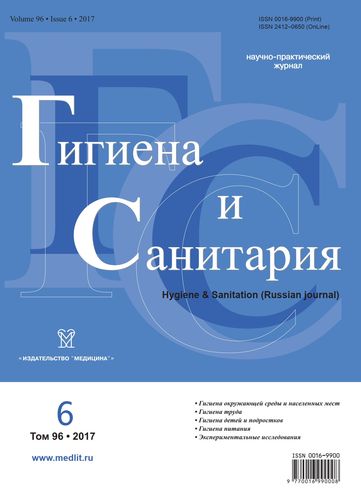STRUCTURAL-FUNCTIONAL REORGANIZATION OF SKIN AND ITS DERIVATIVES UNDER EXPERIMENTAL SUBACUTE OF INTOXICATION BY HEAVY METALS
- Authors: Nikolaeva T.V.1, Polyakova V.S.1, Setko N.P.1, Voronina L.G.1
-
Affiliations:
- Orenburg State Medical University
- Issue: Vol 96, No 6 (2017)
- Pages: 593-596
- Section: EXPERIMENTAL INVESTIGATIONS
- Published: 21.10.2020
- URL: https://j-morphology.com/0016-9900/article/view/640793
- DOI: https://doi.org/10.47470/0016-9900-2017-96-6-593-596
- ID: 640793
Cite item
Full Text
Abstract
There was executed an experimental study of the effect of salts of heavy metals (nickel, chromium, lead and zinc) entering the body by peroral route, on the morphology of the skin and its derivatives (hair follicles and sebaceous glands). The experiment was performed on C57BL / 6 mice with the use of the induction of hair follicle cycle by depilation. Under the subacute intoxication with salts of nickel, chromium and lead, there were revealed such signs of a dystrophic anagen as ectopia of granules of melanin in the dermal papilla and perifollicular tissue, enlarged channels of the hair. The duration of the anagen stage if compared with the control did not change. Under the intoxication with salts of nickel and lead there was revealed infiltration by mononuclear dermis and hypodermis. Lead acetate gave rise in the capillary congestion of the dermis, followed by diapedesis of erythrocytes and infiltration of the dermis by siderophages. In the course of the immunohistochemical study of the proliferative activity of keratinocytes of the skin integument derivatives with the use of antibodies to Ki-67, there was revealed a significant increase of proliferative activity of keratinocytes in comparison with the control under the use of a solution of zinc sulphate and sodium dichromate and its decrease with the use of lead acetate solution.
Keywords
About the authors
Tatyana V. Nikolaeva
Orenburg State Medical University
Author for correspondence.
Email: orenderma@yandex.ru
Russian Federation
V. S. Polyakova
Orenburg State Medical University
Email: noemail@neicon.ru
Russian Federation
N. P. Setko
Orenburg State Medical University
Email: noemail@neicon.ru
Russian Federation
L. G. Voronina
Orenburg State Medical University
Email: noemail@neicon.ru
Russian Federation
References
- Banerjee B.D., Chakraborti A., Suke S.G., Ahmed R.S., Tripathi A.K. Xenobiotic-induced immune alterations: Implications in health and disease. Indian. J. Biochem. Biophys. 2008; 45 (1): 7-15
- Теплая Г.А. Тяжелые металлы как фактор загрязнения окружающей среды (обзор литературы). Астраханский вестник экологического образования. 2013; (1): 182-92
- Jan A.T., Azam M., Siddiqui K., Ali A., Choi I., Haq Q.M. Heavy Metals and Human Health: Mechanistic Insight into Toxicity and Counter Defense System of Antioxidants. Int. J. Mol. Sci. 2015; 16 (12): 29592-630.
- Anderson S.E., Meade B.J. Potential health effects associated with dermal exposure to occupational chemicals. Environ. Health Insights. 2014; 8 (Suppl. 1): 51-62.
- Jenerowicz D., Silny W., Dańczak-Pazdrowska A., Polańska A., Osmola-Mańkowska A., Olek-Hrab K. Environmental factors and allergic diseases. Ann. Agric. Environ. Med. 2012; 19 (3): 475-81.
- Al-Mogairen S.M., Meo S.A., Al-Arfaj A.S., Hamdani M., Husain S., Al-Mohimed B. et al. Nickel-induced allergy and contact dermatitis: does it induce autoimmunity and cutaneous sclerosis? An experimental study in Brown Norway rats. Rheumatol. Int. 2010; 30 (9): 1159-64.
- Бурак Ж.М., Сукало А.В., Терехова Т.Н. Воздействие свинцовой интоксикации на человека и животных, влияние на развитие и функции зубочелюстной системы (обзор литературы). Медицинский журнал. 2005; (4): 10-3
- Plonka P.M., Handjiski B., Popik M., Michalczyk D., Paus R. Zinc as an ambivalent but potent modulator of murine hair growth in vivo - preliminary observations. Exp. Dermatol. 2005; 14 (11): 844-53.
- Plonka P.M., Handjiski B., Michalczyk D., Popik M., Paus R. Oral zinc sulphate causes murine hair hypopigmentation and is a potent inhibitor of eumelanogenesis in vivo. Br. J. Dermatol. 2006; 155 (1): 39-49.
- Paus R., Handjiski B., Eichmüller S., Czarnetzki B.M. Chemotherapy-induced alopecia in mice. Induction by cyclophosphamide, inhibition by cyclosporine A, and modulation by dexamethasone. Am. J. Pathol. 1994; 144 (4): 719-34.
- Slominski A., Paus R., Costantino R. Differential expression and activity of melanogenesis-related proteins during induced hair growth in mice. J. Invest. Dermatol. 1991; 96 (2): 172-9.
- Maurer M., Handjiski B., Paus R. Hair growth modulation by topical immunophilin ligands: induction of anagen, inhibition of massive catagen development, and relative protection from chemotherapy-induced alopecia. Am. J. Pathol. 1997; 150 (4): 1433-41.
- Бабиченко И.И., Ковязин В.А. Новые методы иммуногистохимической диагностики опухолевого роста: Учебное пособие. М.: РУДН; 2008.
- Петров С.В., Райхлин Н.Т., ред. Руководство по иммуногистохимической диагностике опухолей человека. 3-е изд. Казань: Титул; 2004.
- Müller-Röver S., Handjiski B., van der Veen C., Eichmüller S., Foitzik K., McKay I.A. et al. A comprehensive guide for the accurate classification of murine hair follicles in distinct hair cycle stages. J. Invest. Dermatol. 2001; 117 (1): 3-15.
- Tobin D.J. Aging of the hair follicle pigmentation system. Int. J. Trichology. 2009; 1 (2): 83-93.
Supplementary files









